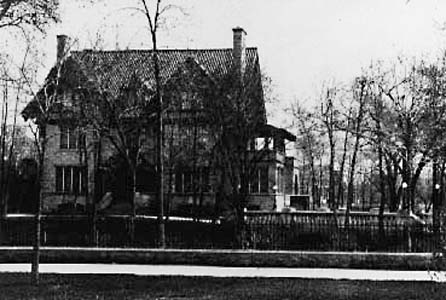Search | Image Archive | Reference | Communities | POV | Lesson Plans | Credits
 With no bridge connecting the land that lay south of the Assiniboine River to Winnipeg, the area that was to become Crescentwood saw very little development before 1870. Several of the lots contained métis farms, and others were used as wood lots, taking advantage of the mature oak tress of the river bottom forest.
With no bridge connecting the land that lay south of the Assiniboine River to Winnipeg, the area that was to become Crescentwood saw very little development before 1870. Several of the lots contained métis farms, and others were used as wood lots, taking advantage of the mature oak tress of the river bottom forest.
In 1880, a bridge was built across the Assiniboine at Main Street, and Winnipeg's first real suburb, Fort Rouge, began to take shape. West Fort Rouge, the area that was to become Crescentwood, River Height and Tuxedo, was still largely inaccessible, and until the construction of the Boundary (Maryland) Bridge in 1896, there were only a few homes in the area.
Crescentwood began to take its present form in 1902 through a combination of need and boosterism. Winnipeg's wealthy had traditionally lived in the city in neighbourhoods like Point Douglas and Armstrong's Point. By 1900, however Point Douglas was becoming a downtown industrial area, and Armstrong's Point was fully developed. Crescentwood was the logical choice for those with wealth who were seeking an alternative to downtown.
Shrewd developers ensured that only the "right" type of houses were built by convincing the city to agree to a series of caveats. These were special building codes which specified size and location of house, and ensured that Crescentwood would be home only to large houses and mansions set well back on the street and on lots two to three hundred feet deep. This strategy worked, and between 1900 and 1914, Crescentwood became populated with stately homes. It became an enclave for the very rich and for members of the affluent professional and commercial classes.
Crescentwood was a suburb whose sense of community was reinforced by ethnic and occupational bonds. Its residents were overwhelmingly of British, American or British-Canadian extraction. They were connected to each other through commercial ties as directors of banks, business organizations, and charities. Many were members of élite social clubs, and Crescentwood ties were often reinforced at social events in the posh cottage country at Lake of the Woods and Minaki.
This ostentatious show of wealth became an important symbol for Winnipeggers. For some, a house on "the Crescent" was the badge of success, an for others it was something to admire and aspire to. For many, it underscored the vast disparity between the lives of working people and those who employed them.
It was no coincidence that on June 5, 1919, members of the Great War Veteran's Association who supported the General Strike paraded across the Boundary Street Bridge into Crescentwood. Their march took them down Wellington Crescent to the Osborne Street Bridge and then to the Legislature. This must have been a remarkable and angering experience for many unemployed veterans, as with the exception of domestic servants and groundskeepers, few working people would otherwise have ventured into the neighbourhood to learn what was there.
TimeLinks Characters: William Scott is a hardware dealer from Ontario and Mary Bentley is a music teacher. Both live in Crescentwood.
Page revised: 29 August 2009